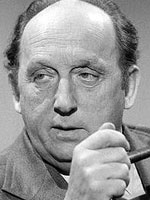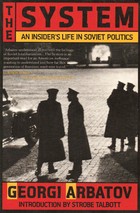A Tale of Two Georges
by Yale Richmond
Romney’s advance party arrived in Moscow in early December to make plans for his visit later that month. In a meeting at the American Embassy, they asked if their man could meet with a group of average Soviet citizens, a request not unusual for an American politician. But the Vietnam War was escalating, US-Soviet relations were not good, and it was questionable whether Soviet authorities would give their approval. As the Embassy’s Counselor for Press and Cultural Affairs, I replied that the Soviets could certainly arrange such a meeting if they wished, but I warned not to expect average citizens. But since the American ambassador could not play partisan politics by hosting a meeting for a candidate for US political office, who then could do it?


Moscow at that time had an Institute for Soviet-American Relations, a “quango” (quasi non-governmental organization), affiliated with the network of Soviet friendship societies that conducted cultural exchanges with other countries. Staffed with personnel who had served in the United States, the institute was knowledgeable about America and well qualified to host the meeting if higherups gave the go-ahead. But the American embassy did not have official contact with the Institute, regarding it as a Soviet effort to end run the intergovernmental exchange agreement. However, in a meeting with Ambassador Thompson, I argued that the Institute could be useful to us, and it was time to recognize its existence. Thompson concurred, and when the Romney advance party met with Institute officials, they readily agreed to host the proposed meeting with “average” Soviet citizens which was to take place in Friendship House (Dom druzhbi), home of the Soviet friendship societies.
After arriving in Moscow on December 18, Romney was briefed by Ambassador Thompson and visited the Moscow automobile factory where, as a successful Detroit auto tycoon, he kicked a few tires and talked shop with his Communist counterparts. (If there was one type of American that Russian Communists respected, it was the successful capitalist.) Romney also had several photo ops, including a pre-dawn jog in Red Square with embassy Marine guards.
The highlight of the Romney visit was a meeting with Soviet Premier Aleksei Kosygin in the Kremlin where they discussed Vietnam, arms control, the Arab-Israeli conflict, and US-Soviet relations. The Kosygin meeting was a surprise because the war in Vietnam was raging, and earlier that year Soviet officials had refused to meet with former Vice President Nixon when he had visited Moscow. Romney, however, opposed the war and was publicly espousing a neutralization of Vietnam.
Romney’s meeting with average Soviet citizens was scheduled for 4 P.M. following a sightseeing tour of the Kremlin. Thirty minutes before the meeting was scheduled to start, I received a call from Dmitri Muravyev, Secretary General of the Institute for Soviet-American Relations, who requested that the meeting be postponed because he could not round up enough Soviet citizens. There were no cell phones in those days, so I explained that Romney was out sightseeing and could not be reached, and I urged the Institute to continue its efforts to find more citizens.
Twenty minutes later, only ten minutes before the scheduled start, Muravyev called again, frantic this time, and said that the meeting must be postponed because he simply could not get enough Soviet citizens to attend. I suggested that he call the Ministry of Foreign Affairs, Pravda, and TASS, adding that they must have people there who would welcome the opportunity to meet a man who might be the next American president. I even suggested that the Institute had the wherewithal to round up some citizens from Moscow streets, if necessary. Concluding the conversation, I said that I would be at Friendship House in ten minutes as earlier agreed.
At 4 P.M. I was at the curb in front of Friendship House as Romney pulled up in the Ambassador’s Cadillac, unaware of any hitch in the planned event. Opening the car door, I escorted him into the building where, to my surprise, some fifty of the most prominent Moscow citizens were assembled–scholars, scientists, journalists, and government officials. Waiters were standing by with trays of vodka and zakuski (Russian hors d’oeuvres), and the meeting commenced with no indication, or explanation, of the reported difficulties in rounding up average citizens.
At the reception I was introduced to a Russian, Georgy Arbatov, whose name was new to the embassy. When asked what he did, Arbatov replied that he had just been named to head a new Institute for USA Studies (Canada was to be added later), also unknown at the time. When asked about his qualifications for the job and whether he had ever visited the United States, Arbatov replied with one of his clever one-liners. “I am neutral on the United States,” he said with a smile, “because I have never been there, and that is why I have been chosen for the job.”


Romney departed Moscow for Israel and other stops on his round-the-world trip but his bid for the Republican nomination was not successful. Richard Nixon was eventually received by Soviet officials but only after he had become president and initiated détente, a new chapter in US-Soviet relations.
Arbatov’s career in international affairs, however, was just beginning, and in the following months I met with him several times to discuss his initial US visit, scheduled for September 1968. Arbatov wanted the American Embassy to expedite his US visa and facilitate his meetings in Washington. The visit was delayed, however, by one of those unforeseen events that, from time to time, have set back US-Soviet relations– this time, the Soviet invasion of Czechoslovakia in August 1968.
Acting on instructions from the State Department, it fell to me to inform Arbatov that his visit to the United States so soon after the invasion “would not be productive,” meaning that he would not be received by US officials. His long awaited American debut had to be put off until after the inauguration of Richard Nixon as president.
Arbatov eventually made his American debut in 1969, seven months later than originally planned. On that visit, in a call at the State Department, Arbatov kept his US host, Department Soviet specialist Boris Klosson, waiting for ten minutes, most likely by plan, and in receiving Arbatov, Klosson noted that he was ten minutes late.
“No,” replied Arbatov with another of his one-liners, “I am seven months and ten minutes late.”
Winston Churchill once described Russia as “a riddle, wrapped in a mystery, inside an enigma,” and for many years I wondered what had caused the attempted postponement of Romney’s Friendship House meeting at almost the last minute. The answer to that riddle came in 1991 during a chance encounter I had in Moscow with a Russian official who had helped to plan the Romney visit.
Shortly before the Romney meeting at Friendship House was to start, I was told, his Soviet hosts realized that they had failed to request authorization from higherups in the Party. A call to the Central Committee revealed that there was no objection to the meeting but no one there was willing to give the authorization without going still higher in the Party hierarchy.
The Party official whose authorization was needed was Mikhail Suslov, the Politburo member in charge of ideology, but no one at the Central Committee staff had the courage to call such a high and mighty figure. When someone was finally found who dared to call Suslov, he readily gave his approval, only minutes before the scheduled start.
George Romney did not make it to the White House but Georgy Arbatov continued to head the Institute for US and Canadian Studies for many years, serving as an apologist abroad for a succession of Moscow leaders from Brezhnev to Gorbachev and Yeltsin.![]()
This article is a subchapter from the author’s book, Practicing Public Diplomacy: A Cold War Odyssey, published by Berghahn Books, New York and Oxford, 2008.

Yale Richmond is a writer and former Foreign Service Officer who lives in Washington, D.C. His latest books are Understanding the Americans: A Handbook for Visitors to the United States (Hippocrene Books, 2009), and From Nyet to Da: Understanding the New Russia 4th edition (Intercultural Press, 2009). He served in Moscow as Counselor for Press and Culture, 1967-69.
